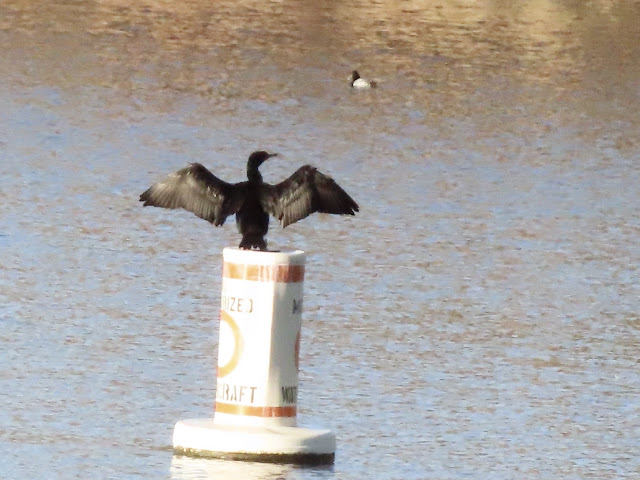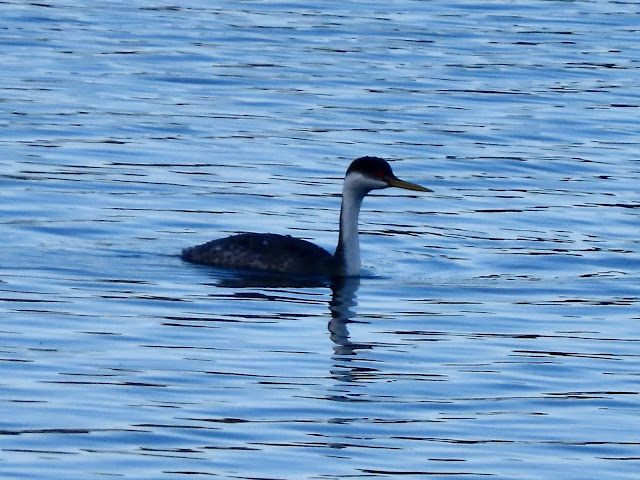Wednesday, December 15, 2021
Greeted by mist rising off the cove water of Saguaro Lake, we watched as flocks of GREAT-TAILED GRACKLE with a lone RED-WINGED BLACKBIRD among them landed on the shoreline just beyond us.
Basic (non-breeding) plumaged RED-WINGED BLACKBIRD on shoreline foraging for breakfast.Slowly, we identified the waterfowl in the corner below the mountain of rock rising above it. With the mist, I was unable to get photos of the LESSER SCAUP (7), a pair of BUFFLEHEAD, a small flock of RUDDY DUCK as well as a couple AMERICAN COOT.
Beside the marsh grasses reaching out from the beach on the other side of the cove, more AMERICAN COOT foraged as a small group.
It wasn't until we walked the trail toward Peregrine Point that we were able to see the waterfowl more clearly. A PIED-BILLED GREBE kept diving just below us near the grasses.

In front of the marsh grasses, two RING-NECKED DUCK and one female RUDDY DUCK were checking out the morning scene. Photo below.

Overhead, two RING-BILLED GULLs, circled, then skimmed the water for tidbits before rising again and continuing with their wide circles above the cove.
At Peregrine Point, we were able to scope a flotilla of mixed-waterfowl containing over One Hundred (100) WESTERN GREBE and more of those species we had seen closer to shore. Luckily, two WEGR were reasonably nearby for photos.
With its red eye well within its black cap and the bill more olive than bright yellow, we were able to detect the WESTERN GREBE from any Clark's Grebes. There were no Clark's in the large flotilla either. Their bills would have shone brightly in the morning sunlight.
Although we scoured the trails and land within the driving circle, birds were scarce this morning. Having started at 8 a.m., we hadn't counted on the 41° temperature at that hour. So, until the sun warmed things up enough for insects to come out, we settled for a pair of NORTHERN CARDINAL, a BLACK PHOEBE, and a GRAY FLYCATCHER.
No matter how much I cajoled the male to move away from limbs, it stubbornly refused. The female, not far from it, allowed me a bit more space to show it off with a photo.

For me, our best sighting was the GRAY FLYCATCHER. We know that it is the only flycatcher that dips its tail downward when perched, like the Black Phoebe. Another key ID marker is its mandible (bill) that's yellow below and black above. The yellow on the lower mandible is marked with a small dark tip that then seems to just flow up and over the top black mandible.
After enjoying 17 species at Butcher Jones, we stopped briefly at Saguaro Lake.
The only new species was a VERDIN. File photo below shows one at the Riparian Preserve earlier this year; we also have this species in the Pueblo. Very small (4.5") with pointy bill.
Until next time, keep your eye on these birds. Joyce K. had the good fortune of seeing a murmuration of Starlings twice last week when out early to walk her dog.
* * *
View this checklist online at https://ebird.org/checklist/S98920243
View this checklist online at https://ebird.org/checklist/S98921525










No comments:
Post a Comment